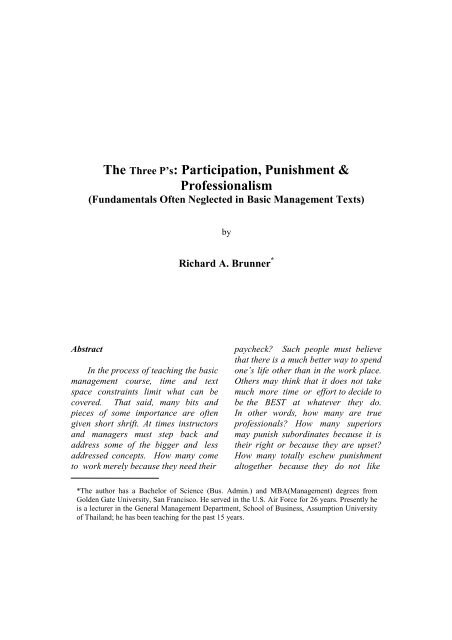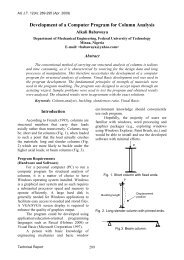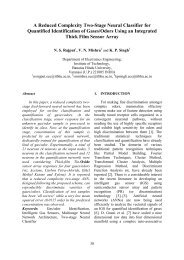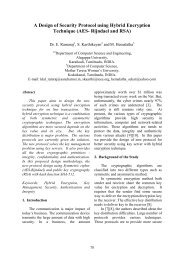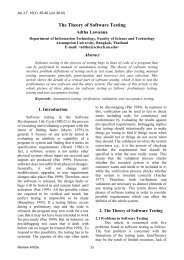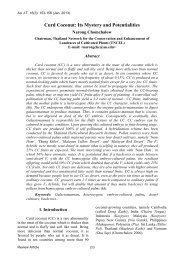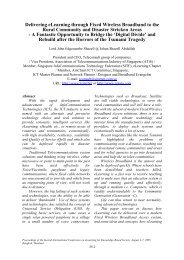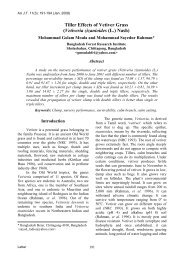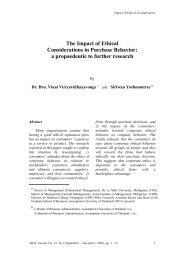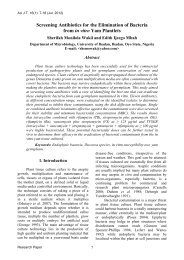PDF format - AU Journal - Assumption University of Thailand
PDF format - AU Journal - Assumption University of Thailand
PDF format - AU Journal - Assumption University of Thailand
You also want an ePaper? Increase the reach of your titles
YUMPU automatically turns print PDFs into web optimized ePapers that Google loves.
The Three P’s: Participation, Punishment &<br />
Pr<strong>of</strong>essionalism<br />
(Fundamentals Often Neglected in Basic Management Texts)<br />
by<br />
Richard A. Brunner *<br />
Abstract<br />
In the process <strong>of</strong> teaching the basic<br />
management course, time and text<br />
space constraints limit what can be<br />
covered. That said, many bits and<br />
pieces <strong>of</strong> some importance are <strong>of</strong>ten<br />
given short shrift. At times instructors<br />
and managers must step back and<br />
address some <strong>of</strong> the bigger and less<br />
addressed concepts. How many come<br />
to work merely because they need their<br />
paycheck? Such people must believe<br />
that there is a much better way to spend<br />
one’s life other than in the work place.<br />
Others may think that it does not take<br />
much more time or effort to decide to<br />
be the BEST at whatever they do.<br />
In other words, how many are true<br />
pr<strong>of</strong>essionals? How many superiors<br />
may punish subordinates because it is<br />
their right or because they are upset?<br />
How many totally eschew punishment<br />
altogether because they do not like<br />
*The author has a Bachelor <strong>of</strong> Science (Bus. Admin.) and MBA(Management) degrees from<br />
Golden Gate <strong>University</strong>, San Francisco. He served in the U.S. Air Force for 26 years. Presently he<br />
is a lecturer in the General Management Department, School <strong>of</strong> Business, <strong>Assumption</strong> <strong>University</strong><br />
<strong>of</strong> <strong>Thailand</strong>; he has been teaching for the past 15 years.
confrontation? Punishment or<br />
discipline is something managers<br />
sometimes use when all other forms <strong>of</strong><br />
motivation fail. If punishment is used,<br />
will it damper efforts to fully make use<br />
<strong>of</strong> participation? Will it reach its key<br />
objective - - behavior modification?<br />
How many managers automatically<br />
assume that their subordinates will be<br />
excited to help them in reaching<br />
organizational goals? People can<br />
become very excited about reaching<br />
their own goals. Is it possible to<br />
develop mutually dependent<br />
organizational and pr<strong>of</strong>essional goals<br />
that can help develop participation and<br />
the team commitment and motivation<br />
that come with it?<br />
PUNISHMENT<br />
Punishment was not a topic<br />
discussed in the last sixteen or more<br />
basic management textbooks that were<br />
used or considered for use at<br />
<strong>Assumption</strong> <strong>University</strong>. The only time<br />
the word ‘punishment’ was mentioned<br />
was when referring to Reinforcement<br />
Theory by B. F. Skinner (and that, only<br />
if the author discussed all four parts<br />
<strong>of</strong> the theory). Punishment, however,<br />
is as much a part <strong>of</strong> the study<br />
<strong>of</strong> management as power and<br />
empowerment. Punishment differs<br />
from negative reinforcement in that<br />
punishment is any process that is likely<br />
to decrease future behavior while<br />
negative reinforcement serves as a<br />
deterrent to punishment.<br />
Reward and punishment - - positive<br />
and negative stimulus, or ‘the Carrot<br />
and the Stick,’ - are still strong<br />
motivators, regardless <strong>of</strong> the researches<br />
and theories <strong>of</strong> motivation. The<br />
problem is that, too <strong>of</strong>ten, everyone gets<br />
a ‘carrot’ that is not related to his<br />
performance. When this happens, no<br />
one gets motivated. The existence <strong>of</strong> the<br />
‘carrots’ is then only what Herzberg<br />
would call “maintenance” or “hygiene”<br />
factors - remove them and<br />
dissatisfaction sets in.<br />
The ‘stick,’ or fear <strong>of</strong> a negative<br />
stimulus; e.g., loss <strong>of</strong> income, job, or<br />
face, is a strong motivator, but may<br />
very well bring on defensive or counter<br />
productive behavior, or even<br />
dishonesty. It does not matter whether<br />
one is a c.e.o. or first line supervisor,<br />
position power that grants a supervisor<br />
the ability to give rewards and<br />
punishment also gives them the power<br />
to control. It should not surprise<br />
anyone that this leads to managers that<br />
cannot recognize that they are<br />
surrounded by sycophants, or ‘yes<br />
men.’<br />
Today it is probably reasonable to<br />
assume that the traditional negative<br />
view <strong>of</strong> punishment or ‘discipline’ is<br />
outdated. Even though basic<br />
management text books, for the most<br />
part, eschew the issue <strong>of</strong> punishment or<br />
discipline, people still need to be<br />
encouraged to do their best and there is<br />
definitely a need to deal with problem<br />
employees before the problems get out
<strong>of</strong> hand. In the U.S., employee<br />
litigation is commonplace and the old<br />
ideas expressed in some basic<br />
management texts that the only<br />
punishment that should be used is<br />
dismissal is not always a satisfactory or<br />
even a feasible alternative.<br />
In some countries, managers still<br />
have a strong hand and they can<br />
probably follow the old dictates, but<br />
even in many <strong>of</strong> these countries,<br />
cultural constraints and other<br />
impediments may make it difficult to<br />
dismiss problem employees that do not<br />
measure up.<br />
What is needed today is not an<br />
elimination <strong>of</strong> punishment, but a<br />
‘progressive’ disciplinary program.<br />
Address the problem employees and<br />
situations before they become out <strong>of</strong><br />
control. Some books have been written<br />
that addressing the issue and even<br />
providing a structured <strong>format</strong> on how<br />
the process can be implemented. Paul<br />
Falcone’s book 101 Simple Write-Ups<br />
for Documenting Employee<br />
Performance Problems by Amacom in<br />
1999 is a good book for every manager<br />
to read and a very good book to help<br />
the Human Resource Management<br />
(HRM) staff in drawing up and<br />
explaining the various types <strong>of</strong><br />
progressive or escalating warnings that<br />
normally begin with verbal or nonwritten<br />
admonitions, then move to<br />
coaching, and, if need be, on to written<br />
warnings and, finally, end with<br />
dismissal.<br />
Of course, an immediate discharge<br />
is warranted for violations such as<br />
illegal activities and gross<br />
insubordination. One <strong>of</strong> the few times I<br />
witnessed immediate dismissal in<br />
<strong>Thailand</strong> was when an instructor<br />
verbally abused a Catholic Priest and<br />
followed up his verbal assault by<br />
physically kicking the Priest.<br />
Surprisingly, there were some in<br />
authority that wanted to wait a month<br />
and let the fellow go at the end <strong>of</strong> his<br />
contract. The President would have<br />
none <strong>of</strong> it - - the <strong>of</strong>fensive boor was<br />
taken to the airport in a matter <strong>of</strong> hours.<br />
The process <strong>of</strong> progressive<br />
discipline does not simply mean good<br />
documentation even though it is<br />
necessary if the process is to be<br />
effective. The written process may well<br />
include a mutually agreed to<br />
performance plan and concrete<br />
statements <strong>of</strong> positive and negative<br />
outcomes and consequences. Normally,<br />
the employee will have an opportunity<br />
to make comment or rebut the<br />
disciplinary document. Good<br />
communications, good will and a<br />
sincere desire to help the person with<br />
the disciplinary problem overcome it<br />
are essential for any constructive<br />
system if it is to function properly. One<br />
<strong>of</strong> Fayol’s principles, the Principle <strong>of</strong><br />
Discipline, declares that the need for<br />
good superiors all the way up the line is<br />
still apropos. This principle is still valid<br />
and good superiors need to be more<br />
than directors - - they need to be<br />
leaders.
To demonstrate: Being late for<br />
one’s class or dismissing the class early<br />
are not signs <strong>of</strong> pr<strong>of</strong>essionalism in the<br />
teaching corps; actions need to be taken<br />
to correct, when possible, those who<br />
abuse the system. Assume the<br />
university has a policy <strong>of</strong> tolerating no<br />
more than three late arrivals, or three<br />
early dismissals, or any combination <strong>of</strong><br />
these there<strong>of</strong> per semester before the<br />
first letter <strong>of</strong> warning is issued. Also<br />
assume an instructor has been late twice<br />
and had dismissed one class early. This<br />
situation calls for an initial letter <strong>of</strong><br />
warning. Paul Falcone’s book gives<br />
101 sample write-ups that cover most<br />
disciplinary type <strong>of</strong> letters and memos,<br />
and can serve as a guide as to the<br />
procedures to be used. The department<br />
chair’s write-up may look something<br />
like:<br />
Maliwan,<br />
Timeliness is a condition <strong>of</strong><br />
employment. In order to set the<br />
example for students and to insure<br />
good class discipline, instructors<br />
must be on time. Dismissing class<br />
early is normally a sign <strong>of</strong><br />
unpreparedness. Both being late to<br />
class and early class dismissal are<br />
signs <strong>of</strong> unpr<strong>of</strong>essionalism.<br />
The <strong>University</strong> has paid sick leave<br />
and a nurse available should an<br />
instructor’s health prevent him from<br />
meeting the class schedules. There<br />
are no indications that you were ill<br />
as you did not apply for sick leave or<br />
visit the nurse. Moreover, you<br />
checked in present for work on one<br />
<strong>of</strong> the days that you were late to<br />
class an hour before the scheduled<br />
class. You have incurred two<br />
reported incidents <strong>of</strong> lateness and<br />
one <strong>of</strong> dismissing your class early.<br />
The dates and times are:<br />
2/6/00 0820 L<br />
3/9/00 0850 E<br />
4/6/00 0950 L (reported<br />
present at 0845)<br />
These incidents have set bad<br />
examples for students and fellow<br />
instructors and cast the department<br />
in a bad light with the Dean. As you<br />
should be aware, any combination <strong>of</strong><br />
three incidents <strong>of</strong> late class starts<br />
and/or early class dismissals in a<br />
semester fails to meet <strong>University</strong>’s<br />
standards and conduct policies for<br />
classroom teachers (Faculty Manual<br />
chap. 5, paragraphs 1-4).<br />
Performance Improvement Plans:<br />
- Measurable goals. Maliwan, I<br />
expect you to immediately<br />
improve your tardiness to class<br />
and early class dismissal<br />
performance.<br />
- A copy <strong>of</strong> pertinent policies is<br />
attached. Please read them and<br />
should there be any question, I<br />
will be pleased to answer them<br />
tomorrow.<br />
- Interim Performance Report.<br />
None is required as your annual<br />
performance evaluation is due in<br />
three months’ time.
- Should you have any ideas as to<br />
how to improve your time<br />
problem, I hope you will share<br />
them with me.<br />
Outcomes and Consequences<br />
Positive: If you meet the attendance<br />
goals, no further action will be<br />
taken as it pertains to this issue.<br />
Your efforts and improvement<br />
will not only help you, but they<br />
will help our department set an<br />
example for our students and<br />
other faculties.<br />
Negative: You are now being placed<br />
on notice that, according to<br />
<strong>University</strong> Policy, should you<br />
reach, in any combination, five<br />
incidents <strong>of</strong> tardiness or early<br />
dismissal <strong>of</strong> class over a two<br />
consecutive semester period, you<br />
will be given a second warning.<br />
A seventh incident over a three<br />
consecutive semester period will<br />
result in immediate dismissal. In<br />
addition, an instructor who has<br />
been given the second warning<br />
will not be eligible for the annual<br />
salary adjustment.<br />
Scheduled Review Date: none<br />
Instructor’s Comments and/or<br />
Rebuttal:<br />
Instructor’s Signature<br />
Of course, different organizations<br />
will have different procedures and<br />
policies concerning the disciplinary<br />
process. In today’s litigating climate,<br />
world organizations need to take<br />
actions to lessen the likelihood <strong>of</strong> their<br />
having to face lawsuits. Even in<br />
<strong>Thailand</strong>, the land <strong>of</strong> non-confrontation,<br />
employee vs. employer cases have<br />
ended up with some regularity in Labor<br />
Court.<br />
Keeping the disciplinary actions<br />
secret may have value, especially in<br />
cultures where face is a primary value,<br />
but there are times when the<br />
disciplinary measures need to be more<br />
formal or even open. If an employee<br />
constantly breaks an attendance or<br />
tardiness rule and others think that there<br />
is no action being taken against the<br />
<strong>of</strong>fender, they may also think that the<br />
<strong>of</strong>fender is above the law, or that the<br />
organization does not care so they may<br />
do likewise.<br />
It should go without saying that a<br />
manager should not punish or fire<br />
anyone or take any other action when<br />
he is angry. The only smart thing a<br />
manager can do if he gets angry is to<br />
get away from the scene. If a manager<br />
has to fire someone, he may need to<br />
‘drag his feet.’ He will need to get his<br />
facts straight before he acts. He should<br />
also give the other subordinates a<br />
chance to see that the person under<br />
review is being treated fairly, but needs<br />
to be fired.
A manager may never fire anyone.<br />
Dismissal is usually the severest form<br />
<strong>of</strong> punishment. Other forms <strong>of</strong><br />
punishment may include: pay cuts,<br />
suspension, demotion, and reprimand.<br />
A simple rule: If punishment is to be<br />
used, use a rifle and not a shotgun. A<br />
rifle is aimed directly at the target but a<br />
shotgun can hurt innocent people.<br />
Often, new restrictions are placed on<br />
everyone because someone abused the<br />
system and the managers want to avoid<br />
confrontation.<br />
(On memos or letters <strong>of</strong> reprimand<br />
on record used by three senior<br />
managers, only one <strong>of</strong> them used it<br />
correctly. The other two managers<br />
started out correctly with memos and<br />
meetings, but had turned the memos<br />
into threats addressed to everyone.<br />
Soon after the first memo was written,<br />
they announced that ‘the memo was<br />
issued to record some poor behavior,<br />
but it does not really mean anything.<br />
However, if someone gets two such<br />
letters, that person will be dismissed.’<br />
A secret memo is useful in that it is<br />
completely secret. The manager and<br />
the subordinate can maintain a<br />
reasonable working relationship. When<br />
managers use threats to control their<br />
employees, imagine the damage that is<br />
done to work environments.<br />
PARTICIPATION<br />
In participation, as with<br />
punishment, culture plays a role in<br />
determining whether or not it will be<br />
accepted or rejected or resented by the<br />
employees themselves. Workers may<br />
see their involvement in setting goals<br />
and making decisions as illegitimate.<br />
Reading Victor H. Vroom and Authur<br />
g. Jago’s book The New Leadership:<br />
Managing Participation in<br />
Organizations, Prentice Hall 1988, two<br />
cases were noticed concerning this<br />
issue. The first, an experiment in the<br />
U.S., showed that resistance to change<br />
in work methods could be reduced by<br />
having those involved in the process<br />
participate in coming up with a<br />
solution. A later effort to replicate the<br />
U.S. experiment in Norway failed. The<br />
second was a U.S. firm that opened a<br />
new plant in Puerto Rico and<br />
implemented its highly successful U.S.<br />
participatory practices only to see them<br />
fail. From exit interviews, they learnt<br />
that the employees thought that the<br />
practices reflected unfavorably on the<br />
capability <strong>of</strong> the leaders, and that<br />
requiring them to participate in goal<br />
setting and decision making was<br />
illegitimate. In <strong>Thailand</strong>, many will see<br />
participation as illegitimate. Some<br />
would think that the manager is weak<br />
and wants them to do his job for him<br />
without his pay and perks. Thus, even<br />
managers who believe in participation<br />
may find that it is not as easy to<br />
implement such a system as they may<br />
believe. That said, participation has<br />
become a hot topic and “Team”<br />
management and implementation texts<br />
abound.<br />
Nearly a century ago, Henri Fayol<br />
wrote the Principle <strong>of</strong> Esprit de Corps<br />
regarding the importance <strong>of</strong> pride and
individual commitment within a unit<br />
and the power <strong>of</strong> cooperation among<br />
the unit members. Fayol emphasized<br />
the need for teamwork and the<br />
importance <strong>of</strong> communication. Since<br />
that time, others including Mary Parker<br />
Follett have recognized and taught the<br />
importance <strong>of</strong> the individual. Fred E.<br />
Fiedler’s Contingency Theory <strong>of</strong><br />
Leadership states that leaders would be<br />
most effective in average situations if<br />
they were oriented toward people and<br />
relationships rather than the task. (The<br />
writer finds most management<br />
situations to be in the ‘average’<br />
category.) One <strong>of</strong> the easiest methods<br />
that almost all managers can use to<br />
create esprit de corps and a people<br />
orientation is through participation …<br />
for a shop or a corporation (or any unit<br />
in between).<br />
The concept <strong>of</strong> teamwork today is<br />
quite different from that <strong>of</strong> two decades<br />
ago. One needs to get people to<br />
‘willingly’ strive to achieve<br />
organizational goals. Ordering people<br />
to do this or that is out or on the way<br />
out. Managers need skills that allow<br />
them to take into account team member<br />
needs rather than his and her needs.<br />
Even though participation and<br />
teamwork are widely discussed in some<br />
<strong>of</strong> these textbooks, they have not yet<br />
been put into practice in many<br />
situations that would seem to call for<br />
them. It appears that in many situations,<br />
‘Empowerment’ and ‘Teamwork’ can<br />
be truly and effectively used. Bossy<br />
bosses are going out <strong>of</strong> fashion.<br />
Participatory bosses, however, need to<br />
hold McGregor’s Theory “Y” views <strong>of</strong><br />
man. In short, these views hold that<br />
given the right conditions man is by<br />
nature creative and is willing to work,<br />
accept and even seek responsibility to<br />
achieve meaningful (to him) goals. The<br />
ideas expressed in these books may<br />
appear radical to some, and may even<br />
be unacceptable to others. That said,<br />
when a company makes the<br />
determination to change to the new,<br />
modern management <strong>of</strong> teams,<br />
managers will need to change their<br />
autocratic ways or they may find<br />
themselves suddenly retired. They<br />
must learn how to effectively use<br />
participation. Managers who can<br />
effectively implement the system when<br />
the situation calls for it will get better<br />
results from their efforts, and will<br />
insure themselves a place in the future<br />
management hierarchy.<br />
The participation concept works as<br />
well in the old style <strong>of</strong> management as<br />
it does with the newest style. As a<br />
matter <strong>of</strong> fact, participation in the<br />
decision making process has been<br />
around a long time. Back in 529 A.D.,<br />
St. Benedict wrote what has become<br />
known as the ‘Benedictine Rule.’ He<br />
spoke <strong>of</strong> group consultation, and also<br />
recognized the importance <strong>of</strong> the<br />
situation that may require a more<br />
restrictive or selective decision making<br />
process or group.<br />
Without participation, subordinates<br />
are told to work harder by the boss, so<br />
the boss can reach his or her objectives.<br />
Ideally, with participation, we can make
use <strong>of</strong> expectancy theory. If ‘we’ work<br />
together, ‘we’ can reach ‘our’ mutually<br />
inclusive objectives. Everyone who has<br />
worked for a boss in any organization<br />
will agree that the most important<br />
person to everyone in the organization<br />
is his or her boss. The question here is:<br />
Who is the more important, the<br />
manager or his staff? If the subordinates<br />
do a good job, the manager will be<br />
promoted. If the subordinates do a poor<br />
job, the manager may be fired or<br />
moved.<br />
Clearly, the subordinates are more<br />
important. How does the manager see<br />
it? Many may, in their most secret <strong>of</strong><br />
thoughts, still harbor the view that they<br />
are more important. They will need to<br />
get over this belief, or they will be<br />
rolled over by the wheels <strong>of</strong> progress.<br />
To be effective, he has to make one<br />
simple but thorough mental adjustment.<br />
He must come to grips with the fact that<br />
his subordinates are the most important<br />
to organizational and hence to his own<br />
success. If he only pays lip service to<br />
participation and teamwork, his<br />
subordinate team members will quickly<br />
see through the façade.<br />
One only need think <strong>of</strong> a coach<br />
team situation. Some years ago, the<br />
author <strong>of</strong>ten used the Lincoln Electric<br />
Company case in class because it<br />
clearly demonstrated the company’s<br />
strong integrated and intense culture, a<br />
culture that included a strong trust<br />
relationship between management and<br />
the work force. In the 1984 case,<br />
prepared by Arthur D. Sharplin <strong>of</strong><br />
McNeese State <strong>University</strong>, the<br />
President <strong>of</strong> Lincoln is quoted as<br />
saying: “… management is the coach<br />
that must be obeyed. The men,<br />
however, are the players who alone can<br />
win the game.” In that same case,<br />
another executive <strong>of</strong> Lincoln is quoted<br />
as saying, “When you use<br />
‘participation,’ put quotes around it.<br />
Because we believe that each person<br />
should participate only in those<br />
decisions he is most knowledgeable<br />
about. I don’t think production<br />
employees should control the decisions<br />
<strong>of</strong> Bill Irrgang. They don’t know as<br />
much as he about the decisions he is<br />
involved in.” It may appear that there<br />
was no participation at Lincoln but they<br />
had many ways that were very effective<br />
in which everyone could participate.<br />
The case indicated that morale was very<br />
high, labor turnover was almost<br />
nonexistent as no union could ever get a<br />
toe hold in Lincoln. Its productivity was<br />
second to none in the industry. The<br />
salaries <strong>of</strong> the men were twice those <strong>of</strong><br />
the industry? Herzberg in his Two<br />
Factor Theory said that money was not<br />
a motivator and James Lincoln would<br />
agree since he said that money was only<br />
an indicator <strong>of</strong> other values such as<br />
status. James Lincoln said, “Status is <strong>of</strong><br />
great importance in all human<br />
relationship. The greatest incentive that<br />
money has, usually, is that it is a<br />
symbol <strong>of</strong> success.”<br />
The Lincoln case management,<br />
regardless <strong>of</strong> their self-proclaimed<br />
autocratic style <strong>of</strong> leadership, seems to<br />
hold to most <strong>of</strong> the underlying
assumptions <strong>of</strong> McGregor theory ‘Y’<br />
views. How else was it possible that<br />
spans <strong>of</strong> management reach 100 at<br />
Lincoln? Simply because the men are<br />
trained, accept responsibility, and are<br />
self-controlled.<br />
Fiedler’s model would indicate that<br />
the Lincoln situation was highly<br />
favorable to management and that, in<br />
turn, would dictate, according to<br />
Fiedler’s Model, that a task oriented<br />
leadership style will yield the best<br />
result. Lincoln was certainly task<br />
oriented.<br />
Assuming the situation does call<br />
for team decision making and that the<br />
manager has made the permanent<br />
adjustment to his psyche and<br />
understands the truth about who is more<br />
important, the groundwork is prepared<br />
for participation. If he really cares for<br />
and respects his subordinates, they will<br />
know it. Trust is sacred. Trust is earned<br />
and trust must be mutual. To gain<br />
subordinates’ trust, a manager does not<br />
have to party with his employees all the<br />
time or even buy their lunches. What is<br />
needed is a good committed leader, a<br />
shared vision, open communications<br />
and trust. Stephen George’s book<br />
Uncommon Sense: Creating Business<br />
Excellence in Your Organization, John<br />
Wiley & Sons, Inc. 1997 makes<br />
interesting reading for many reasons,<br />
one <strong>of</strong> which is its chapter on Lead by<br />
Serving and its references to trust.<br />
Simple examples: One <strong>of</strong> the<br />
subordinates makes a huge mistake.<br />
When the big boss finds out, he comes<br />
into the <strong>of</strong>fice (in front <strong>of</strong> all <strong>of</strong> the<br />
subordinates) with an angry red face.<br />
Does the manager try to escape by<br />
pointing his finger at another? (Would<br />
it lessen the boss’ anger? No.) Finger<br />
pointing, blaming others or making<br />
excuses are signs <strong>of</strong> fear, not trust.<br />
When one <strong>of</strong> the subordinates has a<br />
great idea and the big boss comes into<br />
the <strong>of</strong>fice smiling and tells the manager<br />
how wonderful it is, does he tell the<br />
boss “Thank you,” or “We thank you.”?<br />
Taking credit for achievements is a sign<br />
<strong>of</strong> a fear environment; sharing credit is<br />
a sign <strong>of</strong> trust. If the manager shields<br />
his subordinates when they are wrong<br />
and praises them in front <strong>of</strong> the big boss<br />
when they are right, trust relationships<br />
can flourish. Restricting and protecting<br />
in<strong>format</strong>ion is a sign <strong>of</strong> fear. Sharing<br />
in<strong>format</strong>ion with those who need it is a<br />
sign <strong>of</strong> trust. In this trust environment,<br />
Esprit de Corps will soar.<br />
Many, if not most, managers have a<br />
terrible performance history in their<br />
handling <strong>of</strong> suggestions. People resist<br />
change. A suggestion from a<br />
subordinate is a recommendation to<br />
change something. If someone has<br />
studied management, he should know<br />
that when a subordinate makes a<br />
suggestion, the manager should: (1)<br />
listen, (2) thank him, (3) use the<br />
suggestion if it is good, and (4) explain<br />
why the suggestion cannot be used.<br />
Listening and thanking are easy, if<br />
sincere. Using a suggestion, that is<br />
making a change that was not the<br />
manager’s idea may also be resisted by
nonpr<strong>of</strong>essional and autocratic<br />
managers. Explaining why a good idea<br />
is not going to be used is <strong>of</strong>ten difficult<br />
but necessary. Often, many managers<br />
will make it clear through verbal and<br />
nonverbal means that they do not want<br />
to listen to suggestions. But if ‘we’ are<br />
a team, suggestions will help us reach<br />
‘our’ objectives better and faster. The<br />
best and most useful suggestions for<br />
increasing efficiency or effectiveness<br />
will come from the people who actually<br />
do the work. Managers need all the<br />
suggestions they can get from their<br />
subordinates to increase efficiency and<br />
meet performance goals. A manager<br />
who is both receptive and responsive to<br />
subordinates’ suggestions is almost<br />
guaranteed that their subordinates will<br />
feel important and excited about their<br />
work, and having this trait will go a<br />
long way to insure participation. The<br />
Lincoln Electric Company made<br />
excellent use <strong>of</strong> its suggestion system.<br />
A system that was also tied into<br />
its incentive/performance evaluation<br />
system.<br />
Another area that needs some<br />
attention is the managers <strong>of</strong>ten get upset<br />
when a subordinate complains. We<br />
learn a lot more from those who<br />
complain than those who sit quietly and<br />
never voice any opinion other than that<br />
given by the boss. A trust relationship<br />
exists when subordinates voice their<br />
criticisms, concerns and ideas. In a fear<br />
environment, subordinates keep their<br />
opinion to themselves. One <strong>of</strong> the<br />
biggest jobs the ‘team leader’ (boss) has<br />
is to help solve the problems <strong>of</strong> the<br />
subordinates. Often, these problems are<br />
not work related but they impact on the<br />
work situation. If a subordinate has a<br />
significant problem, too much <strong>of</strong> his<br />
time and thinking is devoted to his<br />
problem, not to productive work. If the<br />
subordinates do not have any major<br />
problems, they are free to do their work<br />
best.<br />
Assuming that the managers can<br />
make the mental adjustment regarding<br />
the importance and true value <strong>of</strong> their<br />
subordinates and subordinates are ready<br />
to participate, participation is a<br />
relatively easy state to achieve.<br />
Managers need to give them<br />
recognition and praise, and to protect<br />
them and to listen to their suggestions<br />
and complaints. The subordinates may<br />
need training. It is the manager’s prime<br />
task to create a positive and<br />
constructive work environment. Today<br />
he needs to create a learning<br />
environment. Managers need to learn as<br />
well. To establish a learning<br />
environment, they need to set standards,<br />
measure, and track the learning process.<br />
They also need to actively engage their<br />
subordinates at every opportunity.<br />
When managers have their subordinates<br />
participate to achieve the unit<br />
objectives, they can use the best<br />
techniques <strong>of</strong> the old management, in<br />
combination with some or all <strong>of</strong> the<br />
modern management. They have the<br />
best chance to get the best performance<br />
from their subordinates, and that is the<br />
Name <strong>of</strong> the Game.
PROFESSIONALISM<br />
Pr<strong>of</strong>essionals in business are the<br />
ones who earn their pay and more. They<br />
also earn the respect <strong>of</strong> almost everyone<br />
they contact. They dedicate their lives<br />
to doing the best at whatever they do<br />
and to the success <strong>of</strong> the organization in<br />
which they work because they fully<br />
appreciate that their success depends, in<br />
large measure, on that <strong>of</strong> the<br />
organization they represent and work<br />
for. The Pr<strong>of</strong>essionals stand out in a<br />
group, and they look as if they have a<br />
mission. They have a mission. Most<br />
employees are dedicated to finishing the<br />
day and getting on with their evening<br />
and weekend plans.<br />
Punctuality is a key point. This is<br />
for managers and employees who are<br />
‘on the way up.’ Punctuality<br />
represents an attitude - - a winning<br />
attitude. In general, we know that<br />
participation increases the time needed<br />
to make a decision. Mintzberg reported<br />
decades ago that managers spend more<br />
than half <strong>of</strong> their time attending<br />
scheduled and unscheduled meetings.<br />
Visualize an embarrassed manager<br />
waiting for a subordinate at an<br />
important meeting. The subordinate has<br />
shown that he is not a pr<strong>of</strong>essional (at<br />
whatever he is doing). The opposite is<br />
also true, subordinates who have been<br />
waiting for the manager/big boss to<br />
show up for a meeting are rightfully<br />
disturbed; the boss has knowingly or<br />
unknowingly sent a message to his<br />
subordinates that may be interpreted by<br />
them as indicating: how busy he is, or<br />
how important he is, or how little he<br />
really respects them. If employees are<br />
paid 200 baht per hour and their<br />
manager wastes an hour <strong>of</strong> working<br />
time for 20 <strong>of</strong> them with some meeting<br />
plus delays, the manager wastes 40,000<br />
baht. When a manager keeps employees<br />
waiting, even accidentally, he wastes<br />
organization time and money. We<br />
should not needlessly add to cost by<br />
tardiness. This article is not specifically<br />
intended to criticize the lack <strong>of</strong><br />
punctuality. In many cultures<br />
punctuality is not considered critical.<br />
In <strong>Thailand</strong>, most <strong>of</strong> South America and<br />
elsewhere for examples, in most<br />
business encounters, many people do<br />
not arrive on time. The winners seem<br />
to be on time. Most people are not<br />
winners.<br />
Punctuality is but one simple<br />
indicator <strong>of</strong> someone’s integrity. The<br />
Pr<strong>of</strong>essionals always do whatever they<br />
said they would do, including being on<br />
time. Integrity is critical to business<br />
success. Fifty years ago, when children<br />
in grammar school said, “I give you my<br />
word I will do it (something),” the child<br />
was making a commitment to do<br />
something; his integrity was on the line.<br />
People do not pledge their ‘word’ very<br />
much any more because when someone<br />
says he will do something, he is using<br />
his ‘words’ to say it. When a<br />
businessman tells an associate that he<br />
will do something by Friday morning at<br />
10:00, that associate does not need an<br />
excuse on Friday morning; he needs the<br />
thing that was promised. Never<br />
promise what you cannot deliver. When
someone ‘breaks his word,’ he has no<br />
integrity. People will tell their friends<br />
and associates about it. If there is any<br />
doubt as to whether or not a manager<br />
can do something, he does NOT give<br />
his word. He can promise to do his<br />
best, but he cannot promise things that<br />
he does not have control over. For<br />
example, a copy <strong>of</strong> a completed report<br />
can be promised because all elements<br />
are in that person’s control. A<br />
replacement part being shipped from<br />
another company cannot be promised at<br />
a certain time because the other<br />
company and shipping factors are not<br />
under his direct control.<br />
One <strong>of</strong> the easiest and most reliable<br />
techniques a person can use to help<br />
maintain his integrity is to keep a<br />
diary/notebook. Every morning, when<br />
a manager arrives at work, he restarts<br />
his notebook before he does anything<br />
else. Under today’s date he writes a<br />
short note from his notes <strong>of</strong> yesterday<br />
that he did not finish. He keeps the<br />
notebook with him all day. He can<br />
keep anything in it that he finds useful,<br />
<strong>of</strong> course, like phone numbers, email<br />
addresses, etc. These can later be<br />
transcribed to a more permanent record<br />
if need be, but the main reason for the<br />
notebook is to record oral<br />
communication. When a superior<br />
makes a request <strong>of</strong> a manager, the<br />
manager makes a note. One <strong>of</strong> the most<br />
important uses <strong>of</strong> the notebook is to<br />
record the promises made to other<br />
pr<strong>of</strong>essionals. The pr<strong>of</strong>essionals in an<br />
organization become known to other<br />
pr<strong>of</strong>essionals. They form the most<br />
important segment <strong>of</strong> the teams that are<br />
tasked to solve company problems and<br />
to make company plans. When one <strong>of</strong><br />
the pr<strong>of</strong>essionals from Marketing, for<br />
example, asks a pr<strong>of</strong>essional from<br />
Engineering for a copy <strong>of</strong> the<br />
specifications <strong>of</strong> a new product, the<br />
engineer can and will help. He wants to<br />
help because he knows that the other<br />
side will do the same for him in time <strong>of</strong><br />
need. Pr<strong>of</strong>essionals must do whatever<br />
they promise, or they ‘break their<br />
word.’ A pr<strong>of</strong>essional who ‘breaks his<br />
word’ once too <strong>of</strong>ten is no longer<br />
considered a pr<strong>of</strong>essional.<br />
Going hand in hand with integrity<br />
is honesty. Intellectual honesty may be<br />
the most difficult trait to acquire.<br />
People do not seem to like to say ‘I<br />
don’t know.’ Pr<strong>of</strong>essionals are honest.<br />
Imagine someone trying to work with<br />
others that they cannot trust.<br />
Pr<strong>of</strong>essional managers do not realize<br />
that their subordinates are watching<br />
them very carefully. A manager might<br />
get away with an expedient lie to<br />
subordinates for a while, but their staff<br />
will eventually find out. These lies do<br />
not help in building trust relationships.<br />
When someone tells a lie, no matter<br />
how minor, to someone, another lie is<br />
<strong>of</strong>ten required to cover up the first - -<br />
then another, etc. Managers need to be<br />
open and honest. Even acts <strong>of</strong> omission,<br />
or pr<strong>of</strong>essions <strong>of</strong> “I don’t know” when<br />
they, in fact, ‘do’ know, must be very<br />
carefully and infrequently used. If a<br />
trust relationship does exist a simple<br />
“I’m not at liberty to say” is a lot better<br />
than a lie. Managing a group <strong>of</strong> people
while fitting in with the organization<br />
and coordinating with others is<br />
complicated enough. Lies, secrets and<br />
manipulation are sure trouble.<br />
Of course, there is a cultural<br />
element even to intellectual honesty. A<br />
friend <strong>of</strong> mine, teaching an MBA class<br />
in Organization Behavior to a group <strong>of</strong><br />
Asian students, once gave an ‘I don’t<br />
know’ (he was not sure) answer to a<br />
student. The student was aghast and<br />
sputtered out loud, “But you’re the<br />
teacher!” My friend laughed and asked<br />
if he was supposed to know everything.<br />
No response came from that student but<br />
the class seemed to get the message that<br />
he was trying to send. Later, the<br />
lecturer ran into the President <strong>of</strong> the<br />
<strong>University</strong>, who said that a student told<br />
him that he (the lecturer) did not know<br />
anything. This lecturer enjoys telling<br />
students that he does not know<br />
something when he is not sure as it<br />
always evokes interesting students’<br />
responses that are very reflective <strong>of</strong> the<br />
culture from whence they come.<br />
Pr<strong>of</strong>essional managers are eclectic,<br />
voracious readers and practice counterattitudinal<br />
listening, especially in highly<br />
charged or emotional situations. This in<br />
part is why pr<strong>of</strong>essionals are normally<br />
the best at whatever they do. If a<br />
Pr<strong>of</strong>essional is not the ‘best,’ he or she<br />
is working and learning to be the best.<br />
SUMMARY<br />
People can be the best at whatever<br />
they do. They can develop the attitude<br />
<strong>of</strong> a winner. They can punish a<br />
subordinate when necessary, but they<br />
need to do it carefully, fairly<br />
constructively and sometimes secretly.<br />
They must consider the future<br />
performance <strong>of</strong> all their subordinates.<br />
If managers can develop a true team,<br />
they can reap the benefits <strong>of</strong> good<br />
Esprit de Corps and Empowerment.<br />
A good way to sum up may be by<br />
relating a recent conversation with a<br />
friend and a colleague <strong>of</strong> the author. He<br />
was invited by an Organization’s c.o.o.<br />
to guest lecture at the initial meeting <strong>of</strong><br />
the Human Resource Management<br />
Development Programs. He was asked<br />
to speak to first line department heads<br />
and their assistants. There were 30 to 40<br />
participants. In order to get a feel for<br />
the situation - - the organization, its<br />
environment and members - - early in<br />
his talk he asked a series <strong>of</strong> questions.<br />
Included among those questions and<br />
response indicators were the following:<br />
1. How many <strong>of</strong> you are satisfied with<br />
all your subordinates?<br />
- Comment: Just about everyone<br />
indicated, without hesitation, that<br />
they had problem people.<br />
2. How many <strong>of</strong> you have<br />
recommended subordinates for no<br />
annual pay increase?<br />
- Comment: Only one Head said<br />
that she did. She went on to<br />
say that she wished she had<br />
not. Her body language, tone
and tenor <strong>of</strong> her voice, and<br />
facial expressions made it<br />
quite clear that she felt that it<br />
was she who was punished.<br />
3. How many <strong>of</strong> you have written<br />
letters <strong>of</strong> reprimand?<br />
- Comment: Only one<br />
responded in the affirmative.<br />
The same Head that<br />
mentioned she had<br />
recommended someone for no<br />
annual salary adjustment.<br />
4. How many <strong>of</strong> you have<br />
subordinates who come to you and<br />
ask for feedback?<br />
- Comment: Only one or two<br />
said that they had - - one being<br />
the same person that said yes<br />
to no pay raise and the letter<br />
<strong>of</strong> reprimand.<br />
5. How many <strong>of</strong> you have gone to<br />
your superior to ask for feedback?<br />
- Comment: None answered in<br />
the affirmative.<br />
6. How many <strong>of</strong> you discuss (show)<br />
your annual evaluations with your<br />
subordinates?<br />
- Comment: The organization<br />
required an annual review.<br />
Only one said yes … the same<br />
person mentioned previously.<br />
7. How many <strong>of</strong> you have seen your<br />
own annual evaluation by your<br />
supervisors?<br />
- Comment: None were shown<br />
their evaluations.<br />
From these responses and others, it<br />
was rather clear to my colleague why<br />
the c.o.o. bypassed his immediate<br />
subordinates and took personal charge<br />
<strong>of</strong> running the newly created<br />
management human resource<br />
development program. It appears that<br />
the c.o.o. knows that his first line<br />
supervisors are far from the<br />
pr<strong>of</strong>essionals that he needs and wants.<br />
My colleague knows that participation<br />
within this organization, another <strong>of</strong> the<br />
c.o.o. desired goals, is not going on in<br />
any meaningful manner. The c.o.o.<br />
must certainly know that overt<br />
punishment is rarely used. My<br />
colleague, however, believes that<br />
punishment is, in fact, used. To him, the<br />
situation appears to be one <strong>of</strong> a classic<br />
fear driven organization. He suspects it<br />
is used in the form <strong>of</strong> favoritism in job<br />
assignments and favorable scheduling,<br />
two step “non”-performance pay raises<br />
for the “in-group” and the like. There is<br />
also a highly developed Thai<br />
punishment technique associated with<br />
social slights, innuendoes and back<br />
biting and all are very likely used. In<br />
short, my colleague surmises that these<br />
Department Heads are only <strong>of</strong>fice<br />
holders who were promoted because<br />
they were sycophantic loyalist to their<br />
immediate supervisors. Their leadership<br />
styles are most likely laissez-faire or
autocratic. They are certainly not<br />
participatory managers, nor are they<br />
maximizers. The c.o.o. probably knows<br />
that he has a very difficult road ahead<br />
as he works toward trying to build<br />
pr<strong>of</strong>essionalism and participation all<br />
the way up the chain <strong>of</strong> command. My<br />
colleague believes that the current effort<br />
<strong>of</strong> the c.o.o., while heroic, is doomed to<br />
failure because the root causes <strong>of</strong> the<br />
problem lie higher up in the<br />
organization’s chain <strong>of</strong> command.<br />
CONCLUSION<br />
Managers are voracious readers<br />
and each <strong>of</strong> the topics so briefly<br />
discussed in this short paper are<br />
covered in books in much greater depth<br />
and scope. The author views<br />
management from a situational or<br />
contingency perspective.<br />
Punishment is but a simple tool that<br />
can and has been effectively used but it<br />
requires a system that is open, fair and<br />
just. It must have an element that can<br />
elicit a favorable response in bringing<br />
problem subordinates into the<br />
mainstream and on to the team.<br />
Participation is a highly complex<br />
process as are the situations and<br />
environments in which they may be<br />
effectively used. Participation and the<br />
degree to which it is used must consider<br />
the total situation. One only needs to<br />
reflect on the old adage: “A camel is a<br />
horse designed by a committee.” Or,<br />
Robert Thorndike’s simple experiment<br />
conducted in 1938 that clearly showed<br />
groups being much superior to<br />
individuals when it came to crossword<br />
puzzle solving, but not when it came to<br />
crossword puzzle construction.<br />
Pr<strong>of</strong>essionalism is a quality that we<br />
hope all our colleagues and managers<br />
possess. A real challenge in today’s<br />
world <strong>of</strong> interdependence and<br />
globalization is the need to recognize<br />
the constraints and limitations brought<br />
about by situational factor <strong>of</strong> which<br />
‘culture’ plays an important role.<br />
Designing participatory and<br />
performance problem systems in<br />
multicultural settings requires a great<br />
deal <strong>of</strong> knowledge and the creation <strong>of</strong><br />
corporate cultures that inculcates,<br />
blends and synthesizes some highly<br />
complex and diverse cultural systems<br />
into a unifying entity. Changing a<br />
culture through an evolutionary process<br />
is a long and difficult process. It may<br />
take years or even a decade. The c.o.o.<br />
<strong>of</strong> the organization in the summary <strong>of</strong><br />
this article is trying to do this but his<br />
organization is facing a severe crisis<br />
and it is doubtful that he will have or be<br />
given the time needed to carry out his<br />
program. The U.S. motto “E Pluribus<br />
Unum” - - out <strong>of</strong> many, one - - seems<br />
apropos, but to bring this about is truly<br />
a challenge for real pr<strong>of</strong>essionals,<br />
especially those working in<br />
multicultural environments.
Reference<br />
1. Bateman, Thomas S. and Snell,<br />
Scott A., Management, Building<br />
Competitive Advantage, 4 ed.<br />
Irwin/McGraw-Hill, 1999<br />
2. Belbin, R. Meredith, Why They<br />
Succeed or Fail, 1981, reprinted<br />
1994<br />
3. Cleland, David I., Strategic<br />
Management <strong>of</strong> Teams, John Wiley<br />
& Sons, 1996<br />
4. Dubrin, Andrew J., The Complete<br />
Idiot’s Guide to Leadership, 2nd<br />
ed., Alpha Books, 2000<br />
5. Falcone, Paul, 101 Sample Write-<br />
Ups Documenting Employee<br />
Performance Problems: a guide to<br />
progressive discipline and<br />
termination, 1st ed., Amacom,<br />
1999<br />
6. George, Stephen, Uncommon<br />
Sense: creating business excellence<br />
in your organization, J. Wiley, 1997<br />
7. Koonze, Harold, O’RDonnell, Cyril<br />
and Weihrich, Management, 8th ed.,<br />
McGraw Hill, 1984<br />
8. Sherriton, Jocalyn and Stern, James<br />
L., “Corporate Culture/Team<br />
Culture: Removing the hidden<br />
barriers to team success”,<br />
Corporate<br />
Management<br />
Developers, 1997<br />
9. Spitzer, Quinn and Evans, Ron,<br />
Heads You Win! How the best<br />
companies think, Simon and<br />
Schuster, 1997<br />
10. Vroom, Victor H. and Jago, Arthur<br />
G., The New Leadership: managing<br />
participation in organizations,<br />
Prentice Hall, 1988<br />
11. Sharplin, Arthur D., The Lincoln<br />
Electric Company 1984, McNesse<br />
State <strong>University</strong><br />
_______


